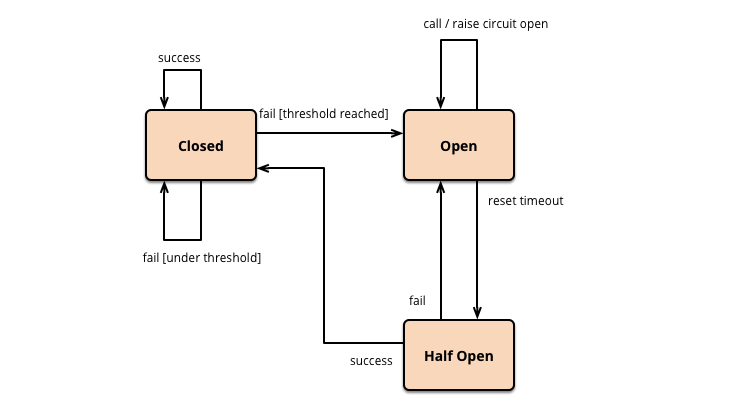Circuit Breaker with Resilience4j and Spring

Summary
When a remote service is down the Circuit Breaker pattern prevents a cascade of failures. After a number of failed attempts, we can consider that the service is unavailable/overloaded and reject all subsequent requests to it. The Circuit Breaker acts like a switch that opens or closes a circuit.
In this post we’ll talk about the resilience4j library that allows us to apply this pattern.
Dependencies
Add the next dependencies to your pom.xml
1
2
3
4
5
6
7
8
9
10
11
12
13
14
15
16
<properties>
<resilience4j.version>0.13.2</resilience4j.version>
</properties>
<dependencies>
<dependency>
<groupId>io.github.resilience4j</groupId>
<artifactId>resilience4j-spring-boot</artifactId>
<version>${resilience4j.version}</version>
</dependency>
<dependency>
<groupId>io.github.resilience4j</groupId>
<artifactId>resilience4j-metrics</artifactId>
<version>${resilience4j.version}</version>
</dependency>
</dependencies>
Configuration
For the next configuration we have defined two circuit breaker configurations, default and serviceA.
1
2
3
4
5
6
7
8
9
10
11
12
13
14
15
16
17
resilience4j.circuitbreaker:
backends:
default:
ringBufferSizeInClosedState: 3
ringBufferSizeInHalfOpenState: 3
waitInterval: 1000
failureRateThreshold: 20
serviceA:
ringBufferSizeInClosedState: 2
ringBufferSizeInHalfOpenState: 2
waitInterval: 1000
failureRateThreshold: 50
# registerHealthIndicator: false
# recordExceptions:
# - org.springframework.web.client.HttpServerErrorException
# ignoreExceptions:
# - org.springframework.web.client.HttpClientErrorException
- ringBufferSizeInClosedState: The size of ring buffer when the CircuitBreaker is closed
- ringBufferSizeInHalfOpenState: The size of ring buffer when the CircuitBreaker is half open
- waitInterval: The wait duration in millis which defines how long the CircuitBreaker should stay open before it switches to half open
- failureRateThreshold: The failure rate threshold above which the CircuitBreaker opens and starts short-circuiting calls
Example of Circuit Breaker
The test
We’ll call to a Consumer that iterate 5 times executing a method that will throw an exception. We will log:
- The begin of method “Entering in service …”
- The exception that will return the service “Exception in method”
- When a CircuitBreaker is opened “Circuit breaker applied”
1
2
3
4
5
6
7
8
9
private static final Consumer<Runnable> consumer = runnable -> IntStream.range(0, 5).forEach(value -> {
try {
runnable.run();
} catch (CircuitBreakerOpenException e) {
log.warn("Circuit breaker applied");
} catch (Exception e) {
log.warn("Exception in method");
}
});
Circuit Breaker using annotations
You could annotate the method or the entire class with @CircuitBreaker annotation. Example for method annotation with serviceA configuration.
1
2
3
4
@CircuitBreaker(name = "serviceA")
public void runWithCircuitBreaker() {
// This code will throw an exception and will not be executed when applies Circuit Breaker
}
An example of 5 invocations to a method that always throws exception, the Circuit Breaker mechanism will be applied. The method will be invoked 2 times and the next 3 times
1
2
3
4
5
6
7
8
2019-01-02 20:15:26.936 INFO ... : Running with circuit breaker using annotations ...
2019-01-02 20:15:26.943 INFO ... : Entering in service ...
2019-01-02 20:15:27.431 WARN ... : Exception in method
2019-01-02 20:15:27.432 INFO ... : Entering in service ...
2019-01-02 20:15:28.106 WARN ... : Exception in method
2019-01-02 20:15:28.107 WARN ... : Circuit breaker applied
2019-01-02 20:15:28.107 WARN ... : Circuit breaker applied
2019-01-02 20:15:28.107 WARN ... : Circuit breaker applied
Circuit Breaker with direct invocation
You can decorate any Supplier / Runnable / Function or CheckedRunnable / CheckedFunction function with CircuitBreaker.decorateCheckedSupplier(), CircuitBreaker.decorateCheckedRunnable() or CircuitBreaker.decorateCheckedFunction()
1
2
CircuitBreaker defaultCircuitBreaker = circuitBreakerRegistry.circuitBreaker("default");
Runnable decoratedRunnable = CircuitBreaker.decorateRunnable(defaultCircuitBreaker, () -> circuitBreakerTestService.run(false));
The same example of the previous case, 5 invocations but applying the default configuration:
1
2
3
4
5
6
7
8
9
2019-01-02 20:15:28.107 INFO ... : Running with default circuit breaker using manual invocation ...
2019-01-02 20:15:28.108 INFO ... : Entering in service ...
2019-01-02 20:15:28.298 WARN ... : Exception in method
2019-01-02 20:15:28.298 INFO ... : Entering in service ...
2019-01-02 20:15:28.485 WARN ... : Exception in method
2019-01-02 20:15:28.486 INFO ... : Entering in service ...
2019-01-02 20:15:28.670 WARN ... : Exception in method
2019-01-02 20:15:28.670 WARN ... : Circuit breaker applied
2019-01-02 20:15:28.670 WARN ... : Circuit breaker applied
References
[1] Link to the project in Github
[2] CircuitBreaker of Martin Fowler Circuit Breaker
[3] Resilience4j in Baeldung Resilience4j
[4] Resilience4j in Github Resilience4j Github
 Never miss a story from us, subscribe to our newsletter
Never miss a story from us, subscribe to our newsletter